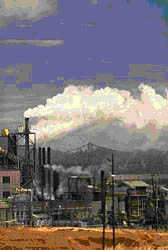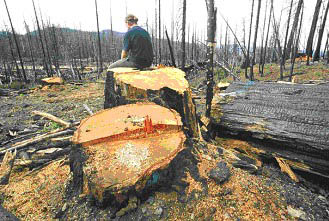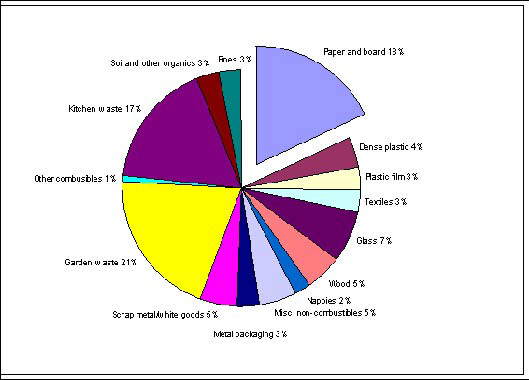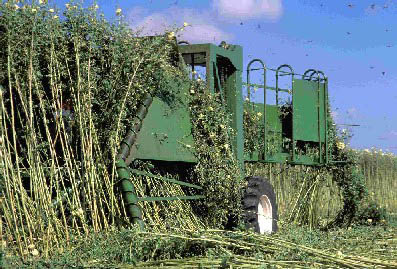

by Peter Hazel, 2007
The world is tearing through paper supplies at an alarming rate. It’s true that paper grows on trees but the amount of waste we are tolerating will eventually catch up to us. With the average American office worker using a sheet of paper every twelve minutes (which equates to a ream every twelve business days) paper consumption has hit an all time high (Tan). Adding to the confusion of this issue; technology should all be but eliminating our reliance on paper. Incredibly, according to the Food and Agriculture Organization, global paper consumption has tripled over the last three decades. What is creating this growing carnage on our paper resource and will our wasteful ways catch up to us? What are the long term affects the destruction of our forests will cause, and what can we do save paper?
The environmental has developed into a hot topic both politically and socially. Dinner party debates along with televised round table conversations have become commonplace. The question is, do we really know what’s going on? If you listen to a Democrat, Armageddon is emanate, a Republican will tell you everything is fine and the world is overreacting. What are the true facts, and what issues could they cause for us as well as generations to come? Fact, America cuts down an average of 3.8 million acres of forestland every year. More than half of these trees go towards the production of paper. Forest land which once was preserved is not being destroyed to increase corporate profits. The upheaval over the destruction of our natural resources is not new. In 1891, President Benjamin Harrison established the first forest reserves, and America’s first forest preservation society was founded in 1898. Headed by the French schooled (America did not offer any courses to study) Gifford Pinchot, the organization’s main focus was to manage America’s forest and create a conservation plan. Kudos to President Harrison for his vision, parks and forests stand to remind us of what we once had and what could be again. They stand as a reminded to treat nature with respect and are a window into the past, providing views and stoking emotions that generations before us experienced. “Central Park where I can get glimpses of the beautiful island that used to exist before it was stolen from the Indians, where rocks and rivers run wild and the trees dress and undress with the seasons, in a strip-tease that upstages all human endeavor” (Keefer.)
National forests were created along with laws governing the harvesting and cutting methods the industry was using. Timber companies survived for decades exclusively harvesting private land, unfortunately this supply would eventually run dry. By the 1980s these companies set their sights on America’s national forests for a renewed supply. By the 1980’s lumber firms were applying enormous pressure on federal agencies to provide them with more lumber. The demand coupled with wealthy lobbyist proved too much temptation for Congress to resist, and by the mid 80’s many national forests were being clear-cut (method for clearing woodlands in which every tree is removed leaving only the stumps). America forestland has decreased almost 50% in the last 25 years. Tennessee, home state to the biggest political celebrity forging war on environmental enemies (personally I think its just for the celebrity), Al Gore has been hit harder by this epidemic than most states. According to the NRDC’s website 200,000 acres of Tennessee forestland has been devoured in the last 4 years. The southern states in America has taken the hardest hit. “There are 156 chip mills and 103 pulp mills in the 13 southern states. More than 100 of the chips mills were constructed between 1987 and 1997, when the chip exports (mostly to Japan) escalated by 500%. Eleven mills get their wood from the plateau. Royal Blue alone eats up 7,000 acres of hardwood trees a year – oaks, tulip poplars, and a half dozen other species – from within a 75- mile radius” (NRDC.)
Every Thursday morning, like clockwork, I come into work to find my copy of Bloomberg magazine waiting for me. Bloomberg magazine covers all aspects of the financial world, and according to its website has 58,000 subscribers. The only issue I have with this magazine is that I have never requested it, nor have I ever opened it. The same holds true for every other member of my work team. Each week we are graced with thousands of magazine pages that we did not request nor do we use. Bloomberg is just one of the offenders I deal with on a weekly or monthly basis. Rep magazine (published as an advertisement for Wachovia), is delivered promptly to my desk every month without any concern for my wants or needs. The reason these magazines are so willing to spend cash on production and tear through natural resources is simple, it makes them money. They report us, and everyone else who receives these magazines (unsolicited), as subscribers. The larger the subscriber base they have, the more they are able to charge advertisers. Ultimately it makes financial sense to give away these magazines in order to cosmetically increase subscriber ship. Magazines like Bloomberg and Rep are able to increase their advertising revenues 10 fold by giving away their product. I spoke with Dan Meehan, the national sales director for HGTV, regarding advertising pricing structure. “All advertising in magazines, online, TV, whatever is based on CPM- which means "cost per thousand" - or the cost to advertise to reach 1000 members of the audience. As an example, a magazine with 1M subscribers and an average cost of $150 CPM, each advertising page would cost: $150,000 (1,000,000/1000 x $150)”. Average CPM costs differ by medium, typical averages below:
Magazines (print): $100-$150 CPM
Online: $5-$75 CPM
TV: $5-$25 CPM (Meehan)
As you can see print ads have the highest CPM of any medium. This is good news for newspaper and magazine owners and bad news for the forests. High advertising commissions motivate these owners to do everything possible to get their product to as many people as possible. If the magazine can give away a million extra copies and report this to advertisers as subscribers, they will be earning an additional $150,000 per page. Multiple that by 50-70 endorsements and you can start to get an understanding of the motivations behind this. Besides magazines who give their product away, the planet is facing issues with magazine over-publication. “Turning the page” reported that of the 4.7 billion magazines sent to newsstands every year, only 35 percent of them are actually purchased. This means that almost 3 billion magazines worth of trees and pollutants are being produced for no reason. To make matters worse the vast majority of these magazines are printed on virgin paper (paper that has no recycled content in it). Environmentalists are citing the use of recycled paper as an easy implementation to help elevate some of our demand on the forests. According to “The Paper Project” the EPA reports that substituting one ton of 100% recycled paper for virgin paper would save 17 trees, 4,100 kilowatt-hours of electricity, 7,000 gallons of water and 60 pounds of air pollutants.


It’s obvious that we have a problem, but why so few American’s not doing more to help. It seems to me the most effective way to get people’s attention is to hit them in the wallet. Recycling laws are ignored or broken, environmental causes flow in and out of vogue, but the one constant attention getter is money. In this spirit, a great way to remedy this problem would to impose a sin tax on paper. Why not, paper is a luxury item, same as cigarettes or liquor. According to Webster’s dictionary a sin tax is a tax levied on cigarettes, liquor, gambling, or other things considered luxuries or non necessities. Now days, more so than ever, paper has become a luxury item. Personal computers, hand held media devices and cell phones have the ability to significantly lower our reliance on paper.

In 2005 cigarette sin tax contributed $13 billion to state budgets. Outside the obvious monetary benefits the cigarette tax has had other beneficial affects. Interestingly, the annual revenue from sin tax has dropped around 5% every year it has been in existence. The reason for this revenue drop is because less people are buying cigarettes (many because of the financial impact created by the sin tax). Studies on the subject have evidenced that a 10 percent price increase can lead to a 3 to 5 percent reduction in smoking in the short run and a drop of double that over longer periods of time. Outside the obvious $13 billion dollars being paid to the government annually, there are hidden costs that need to be taken into consideration. In the cigarette tax example, the government spends an additional $12,000 in health benefits on smokers vs. non smokers. This is not the only hidden benefit to society.
Assuming a similar affect, a 5% decline in paper consumption would equate to 250,000 acres of forest land being saved in the first year alone. According to the paper project this decline would save approximately 20,000 metric tons of toxic air from hitting our atmosphere (Franz). These toxins include sulfur, absorbable organic halides, chloroform, dioxin and furan. Of course there is also monetary validity to this solution. The funds generated from a sin tax could go along way towards research, funding social programs, or possibility subsidizing the cost of education. It is very difficult to approximate how much revenue a sin tax would generate because there are so many different types of paper, which are all priced differently. For the sake of argument, I am looking at everything in reamed paper form (reamed paper comes in 500 sheet packages, weight 5 pounds and cost on average $2.50). According to “The Paper Project”, America consumes 200 billions pounds of paper annually. This equates to 40 billion reams of paper per year. A 5% sales tax on this revenue equates to an astounding $5 billion dollars a year. The tax revenue alone would generate more than five times the 2008 proposed budget ($820,000,000) by the NCI (National Cancer Institute).
g
There are, of course, issues that could arise as a result of a tax like this. Many inner city schools, libraries and recreational facilities already have difficulty affording books and reading material. An additional sin tax on these items could have a significant negative affect on literacy rates in these communities. Reading is Fundamental (RIF); one of the best known and successful reading programs in the country, has an annual budget of a mere $24 million dollars. This figure represents their national budget, which covers all of the organizations advertising, media exposure, and operation costs. Obviously increasing cost to a socially beneficial program like this could have an inverse affect to what the sin tax would be looking to accomplish. As discussed all through out this paper, America is tearing (pardon the pun) through forests and cutting through paper without regard. It’s interesting that in such an environmentally alert time the public out cry is not more effective in resolving this issue. We know that there are more viable options out there to paper. Newspapers are available online, TV is the largest information providing resource ever invented, and do we really need this industry at all? Maybe not in the future, but I think its safe to say that as it stands today paper serves a useful purpose in our lives. Think of the alternatives, these products if not made of paper (and still produced in a tangible form) would most likely be made of plastic.
The issue is like a complex ecosystem that could collapse with the slightest change in the environment. In contrast to the destruction this industry causes to the environment, shutting it down could be equally catastrophic to the workforce as well as the country’s economy. According to the California Forest Products Commission, the forest and paper industry employs 1.7 million Americans and ranks amount the top 10 manufacturing employers in 42 states. These statistics need to be taken with a grain of salt, considering the source but the numbers do have some validity. According to the 2000 US census the forest industry employs over 60,000 Californians whose annual payroll eclipses $1.4 billon. According to this same source regeneration programs have proven to be successful, they claim California’s forest’s growth rate exceeds the harvest activity.
In years past America, like many countries, went plastic crazy. Plastic bags, plastic cups, plastic bottles, plastic table clothes, you name it if we produced it we tried to make it in plastic. Plastic was cheaper to produce, safer than some of the containers being used previously not to mention lighter. It took a few decades before it hit us that this amazing new material, would never disintegrate. The only way to break down plastic material is to burn it. According to the Environmental Protection Agency burning plastic releases Dioxin into the atmosphere. “Dioxin is a generic term for a group of suspected carcinogens extremely toxic to both humans and animals. (It can cause cancer in the lung, liver and stomach as well as non- Hodgkin's lymphoma; it is a million times more toxic than arsenic). It is an unwanted by-product of the manufacture and burning of polyvinyl chloride (PVC) plastics.” Exposure to Dioxins can have a multitude of effects on humans, including birth defects, low sperm counts, hormonal changes, and several types of cancers. These toxins are also produced during the paper production process, but on a much lower scale compared to the production of plastics. The paper industry makes a strong argument that they are not using up natural resources but they are borrowing them. It has become an industry standard that for every tree that a company removes they plant at least one, in many cases more than one.
I think what gets lost most in the great paper debate, is the social side of the argument. In my house, growing up, television was a part of the family. We all gathered around it every night and stared in silence. Talking was permitted during commercials only and if the phone or the doorbell rang the stand off that pursued was as tense as noon at the OK Coral. It wasn’t until I was in my mid-twenties that I voluntarily read my first book. The book was “The Firm” by John Grishom. I was engrossed. I started reading it one evening, I’m not really sure why, but before I knew it I could not think about anything else. I would bring t to work so I could read it on my lunch break, having to fight off the temptation of regain it in traffic on my way. Since then I’ve become an avid reader. I love to read, there is nothing more relaxing then getting totally swept away in a book. I look forward to the days when I can tuck my daughter in and read here a classic Dr Seuss book. The tangibility of a good book, or a magazine, or even an old recipe that’s been handed down from generation to generation is priceless. Think of how many great people have fought for the environment through their written words. People like Thoreau, Emerson, and Virginia Wolf used books to introduce people to nature in ways they never imagined. In her book The Waves, Virgina Wolf eloquently relates reading a clock’s face to a journay through a desert. She using nature in many of her passages to help people better understand what she is describing. All of the great literary genius’ of the past have used some form of paper to express their thoughts and convey their stories. That being said, the total eradication of print or paper products is not a viable solution, not to mention I don’t think America is prepared to install badays in bathrooms across the country. I think it is conceivable to believe that we could limit our use of these products but also potentially find alternatives to the paper we would still need to use. Experts have suggested many alternatives to trees produced paper products, but hemp, kenaf, and cotton are three of the most likely candidates. After all would Shakespere on non wood pulp paper not read as sweet?
Hemp has been touted for years as being a practical alternative for traditional paper. The hemp plant produces fibers commonly referred to as bast. The bast is pulled from the stalk of the hemp plane, which can grow anywhere from 3 to 15 feet high (Herer). The use of hemp as a cotton or a paper product is not new. Hemp was the primary substance in rugs, rope, paper, and sacks as recently as the 1850s. Interestingly the Declaration of Independence is written on hemp, the word canvas itself derives it self from cannabis.
Unfortunately in 1930s the production of Hemp was banned by the United States Government, under the 1937 Marijuana Tax Act. Hemp fails under the act because it contains low levels of THC, which is a psychoactive ingredient found in hashish and marijuana (hemp does not contain an amount to produce any intoxicating effect, even in significant quantities). According to Jack Herer’s book “The Emperor Wears No Clothes” the biggest supporter of the ban account was William Randolph Hearst, who coincidently had significant interest in the timber industry at the time. “In 1916 a USDA Bulletin (#404), reported that one acre of cannabis hemp, in annual rotation over a 20-year period, would produce as much pulp for paper as 4.1 acres of trees being cut down over the same 20-year period. This process would use only 1/4 to 1/7 as much polluting sulfur-based acid chemicals to break down the glue-like lignin that binds the fibers of the pulp, or even none at all using soda ash. The problem of dioxin contamination of rivers is avoided in the hemp paper making process, which does not need to use chlorine bleach (as the wood pulp paper making process requires) but instead safely substitutes hydrogen peroxide in the bleaching process. If the new (1916) hemp pulp paper process were legal today, it would soon replace about 70% of all wood pulp paper, including computer printout paper, corrugated boxes and paper bags.”

Kenaf has also been suggested as a viable alternative to paper produced from trees. Kenaf is a plant originating from Africa and is a member of the hibiscus family. Scientists and agriculturists are currently testing this material as a hopeful alternative to cutting trees. Kenaf can grow as high as 12-14 feet in as little as 4 to 5 months. U.S. Department of Agriculture studies show that kenaf yields of 6 to 10 tons of dry fiber per acre per year are generally 3 to 5 times greater than the yield for Southern pine trees, which can take from 7 to 40 years to reach harvestable size. It is estimated that growing kenaf on 5,000 acres can produce enough pulp to supply a paper plant having a capacity of 200 tons per day. Over 20 years, one acre of farmland can produce 10 to 20 times the amount of fiber that one acre of Southern pine and because kenaf is grown for the fibrous stalk, and not the fruit or flower of the plant, insecticides are not required. America has been flirting with switching to kenaf paper for the last 50 years. In a 1960 survey of more than 500 plants, kenaf was selected as the most promising source of “tree-free” newsprint. In 1970, kenaf (which was produced by Intl Paper) was the paper source used to produce six different U.S newspapers. The refining process for this material requires 20% less energy than producing traditional paper and the fiber does not require dioxin creating bleaches.

The most abundant resource that we could use to alleviate our reliance on lumber for paper would be cotton. Cotton is the world's most widely used natural textile fiber; it’s grown in over 70 countries and makes up nearly half of all clothing produced in the world. About 35% percent of the cotton plant is used for fiber. The rest (seeds and gin trash) go into the food chain, either as industrially processed cooking oil or animal feed. Unfortunately conventional cotton farming is extremely chemical-intensive. According to the California-based Sustainable Cotton Project, in the United States, nearly a third of a pound of chemical fertilizers and pesticides is required to produce the pound of fiber that goes into a T-shirt. Whether cotton paper comes from textile scraps or from cotton linters, the fine fuzz that surrounds a cotton seed, it is important to support sustainable, chemical-free organic cotton farming. Cotton is also often mixed with other recycled paper fiber for a high quality paper type. Pure cotton paper on its own is actually much stronger and more durable than wood pulp paper, it is also is known to last several hundred years without fading or deteriorating. Because of these characteristics cotton paper is commonly used for Legal documents (this paper is available for retail sale – staples, office max, etc. but they tend to be more expensive).

There are many different opinions on the great paper issue. Some are looking for the elimination of paper products all together; others are calling for viable paper substitutes. I personally am in favor of both taxing specific paper products as well as implementing paper alternatives. I think the tax would not only generate impressive revenues (which could potentially fund other environmental causes), it would have an affect on so much more. The potential impact a tax like this could have on the bottom line large corporations and publishers could finally force them to become more conscientious of their paper use. The 5% example in this paper is just a starting point, this tax could potential generate 2 to 3 times as much as previously forecast.
In order to successfully tackle this issue I think we need to take a 4 step process. First off, a sin tax would need to be implemented. As previously mentioned this tax would generate a tremendous amount of revenue but could also be catastrophic to national literacy. The last thing that we want to do is make it more difficult for people to buy books, anyone in college could tell you books are too expensive as already. I would propose issuing this tax on media publications, mass mailings, (ultimately anything that derives it revenue from advertising dollars) and corporate reamed paper. Of course, this would decrease the amount of tax revenue that could be generated. The previous revenue estimated in this paper of $5 billion would be decreased. Limiting this tax to reamed paper only would generate close to a billion dollars on its own, so for the sake of argument we’ll assume the total tax could generate $1.5 billon in tax revenue. Taxes only specific paper sources affords us the opportunity to monitor the affects these taxes would have on common citizens and allow us to limit any negative affects on it might have on society.
The second step we would need to action would be to educate and inform people on the issue. I developed a survey in which I asked 25 people various questions pertaining to the environment and American paper consumption. Some of the questions touched on political agendas; others pertained to basic facts regarding America’s paper use. After all the surveys were completed I followed up with a phone call or a meeting with all the participants. We discussed basic facts and statistics that most Americans are not familiar with (I was not either prior to writing this paper). Some of the topics we addressed were the possibility of implementing a sin tax on paper, the amount of pollution generated in producing paper, the dangers and advantages of hemp, and waste statistics among other things. I then resent the survey to each person I was able to follow up with. Alarmingly, every participant changed at least four of his or her answers. I took this as an indication that Americans are uninformed about the issues. Again I compare this to what has occurred in the tobacco industry. Over the last 10 years, America has seen a huge decline in smokers (especially new smokers). This decrease could be attributed to many factors, one of which, the amount of information that is being distributed to the public. A section of the 1999 Tobacco Settlement (The National Foundation and the National Public Education Fund) sole purpose is to educate people to the facts of the issues. This section decrees that the tobacco industry must fund 50 million dollars annually to educate the American public on the dangers of smoking. Taking a page out of the tobacco settlement we would need to allocate a percentage of the 1.5 billion dollars in tax revenue to help refine the public understanding of the issue. Television commercials could be developed to target children and try to instill this behavior from a young age. We would use these funds to help inject paper conservation into our national culture, much the way we’ve done with eating healthy or smoking.
Steps three and four are closely related. Step three would be to spend some of these revenues on research and development of alternative products. As previously stated, we know there are better alternatives to paper in this country. Hemp reigned supreme for years before the lumber and paper industry got involved. Kenaf and cotton have already proven that they can produce an effective material that could eliminate our reliance on lumber. Lobbyists for these industries spend millions of dollars trying to suppress innovation. In this scenario, the government would be issuing grants to schools and companies who work towards developing more efficient methods of producing these alternative materials, and possibly developing environmentally safe synthetic solutions.
Finally, the government would need to take a proactive strike and use some of these tax dollars to fund farmers and corporations who would be processing these raw materials who would be starting out in the industry. Financial subsidizing along with preferential tax treatment for farmers would help spur momentum in this new industry. Also the additional funds could go to offer tax breaks to corporations who participate in this industry. I believe that once these kinds of incentives are offered it would force the “major players” in the (wood pulp) paper industry to get on board. With the government funding up-and-coming companies just starting out in the business, these companies would have a choice of becoming active in the industry or losing market share.
Again books, boxes and other items that we use everyday are not going away anytime soon. We need to more than ever fund research in hopes of instituting potential paper substitutes. Resolving this problem is no easy task. There are major corporations with deep pockets in the way. Pockets deep enough to house lobbyist’s who armed with checkbooks ready to buy Congressional votes. Can America ban together in one more great fight against tyranny and corruption? We must because the future of the planet depends on it.
Audrey Webb. “Earth Island Journal. San Francisco Chronical: 2007. Vol. 22 Iss. 3; pg. 54, 1 pgs
Tan, Teri. “Definitely Not Pulp Fiction” Publishers Weekly Vol. 254, Iss. 27 (2007); p. S26
Larry Carson. Knight Ridder Tribune Business News. Washington: May 12, 2007. pg. 1
Ira May Joyce P. Pedrasa. “Health Dep’t presses share from ‘sin’ taxes”. BusinessWorld. Manila: Jul 30, 2007. pg. 1
Franz, Damon. “Enviromentalist Team Up to Reform the Magazine Industy.” 2005. The Paper Project http://paperproject.org/.
Audrey Webb. “Earth Island Journal. San Francisco Chronicle: 2007. Vol. 22 Iss. 3; pg. 54 1 pgs
Brunner, Borgna. “Time 2007 Almanac” Pearson Education. Boston, 2007
Meehan, Daniel. Personal interview. 13 September 2007.
Totten, Robert. Personal interview. 17 November 2007.
Hazel, Peter. Personal survey conducted. November 2007.
Food an Agriculture Organization http://www.fao.org/
Bloomberg Magazine http://about.bloomberg.com/index.html
Jack Herer. The Emperor Wears No Clothes (free online addition). http://www.jackherer.com/chapters.html
Wachovia Securities. Registered Rep Magazine. October 2007
http://academic.udayton.edu/health/syllabi/tobacco/summary.htm
West, Clarence. “Papermaking properties of flax and hemp” Institute of Paper Chemistry (1939) 14-15
Postel, Sandra “Air pollution, acid rain, and the futures of forest” Worldwatch Institure (2004) 54-58
Sheppard, Jack. The Forest Killers: the destruction of the American wilderness. New York: Weybright and Talley, 1995
Geological Survey (U.S) Annual report of the Director of the United States Geological Survey to the Secretary if the Interior. Washington: Government Printing Office
Wolf, Virginia. The Waves. New York: Harcourt Brace,1978
Proust, Marcel: Swann’s Way. New York: Henry Hoult and Co. 1922
Abram, David: The Spell of the Sensuous. New York: Vintage Books. 1996
Keefer, Julia: How to Survive as an Adjunct Professor by Wrestling. NewYork: iUniverse, 2006
Essick, Peter. “The Tennesse Tree Massacre.” NRDC website Winter 2004 <http://www.nrdc.org/onearth/04win/cumberland2.asp
Googleimages. http://showcase.netins.net/web/creativecomposties/omages/kenaf%20harvestSmaller.jpg
Ricklefs, Robert. Ecology. Vol.4 WH Freemon and co 1996